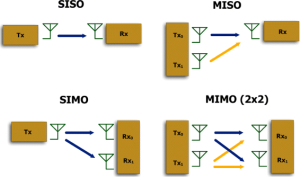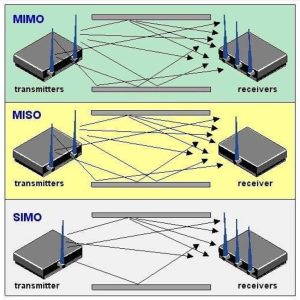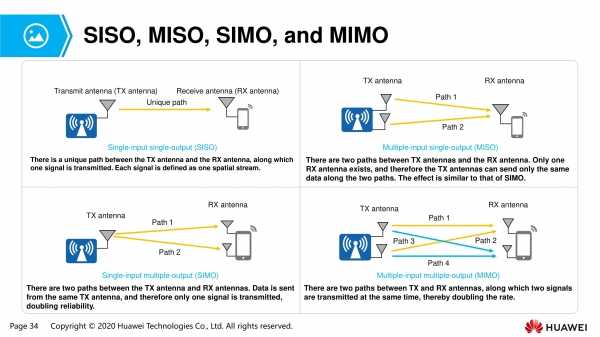MIMO, SIMO, MISO and SISO systems. Four distinct technologies that each offer their own unique approach to wireless communication. But what do these acronyms really mean? It’s a perplexing question for those unfamiliar with the world of wireless technology.

Let’s start with MIMO – Multiple-Input Multiple-Output. This technique utilizes multiple antennas at both the transmitter and receiver ends of a communication system to enhance performance. Sounds simple enough, right? But wait…what about SIMO – Single-Input Multiple-Output? In this case, only the receiver has multiple antennas while the transmitter uses just one.
And then there’s MISO – Multiple-Input Single Output. Now things are getting even more complex as we see that while multiple antennas are used at the transmitter end, only one is utilized at the receiving end of a communication system.
Finally, we have SISO – Single Input Single Output technology where just one antenna is employed on both ends of a communication system.
But why does any of this matter anyway? Well, it turns out that antenna technology plays an integral role in how effectively signals can be transmitted or received within these different types of systems. For instance, in MIMO applications each individual antenna sends its own signal which is then combined with other signals from other antennas to create an overall stronger signal while in SIMO settings each separate antenna receives its own unique signal which is later integrated into an overall enhanced transmission.
The benefits derived from using either MISO or MIMO technologies rather than traditional SISO or SIMO approaches are numerous; improved data rates being chief among them due to their ability to use multiple channels simultaneously thereby making them ideal for high-speed internet access scenarios along with video streaming and gaming applications where speed and quality must not suffer over long distances without disruption caused by fade effects.
Moreover these techniques will become even more crucial as advanced 5G networks come online alongside Wi-Fi 6E which require faster transmission speeds than ever before, necessitating the use of top-notch transmitters and advanced antennae technology capable enough to transmit information across vast distances without any loss in quality or speed.
Antenna technology in MIMO and SIMO systems
Contents
- 1 Antenna technology in MIMO and SIMO systems
- 2 Advantages of using MISO and MIMO in wireless communication
- 3 How fade affects wireless communication in MIMO and SIMO systems
- 4 Transmitting and receiving data in MIMO and SIMO systems
- 5 The role of diversity in MIMO and SIMO systems
- 6 Multiple antennas at the transmitter and receiver in MIMO and SIMO systems
- 7 The future of wireless communication: G, WiFi, and advanced antenna technology
- 7.1 What exactly is MIMO in wireless communication? Could you elaborate further on this technology?
- 7.2 How does SIMO differ from its counterpart, MIMO?
- 7.3 And what about MISO then? Can you shed some light on this concept too?
- 7.4 So what makes SISO distinct from other transmission methods in wireless communication?
- 7.5 Could you explain how antenna technology contributes to shaping modern-day MIMO/SIMOsystems?
- 7.6 What are the key benefits of implementing MISO and MIMO in wireless communication?
- 7.7 How does fade affect wireless communication in multi-antenna systems like MIMO and SIMO?
- 7.8 Could you discuss how data transmitted/received via multi-input antenna technology differs from conventional single input methods?
- 7.9 Can you explain what diversity’s role is within MIMO/SIMOsystems?
- 7.10 Lastly, what innovations/changes do we anticipate seeing soon regarding wireless communications?
The intricate world of wireless communication is fraught with complexities, and antenna technology stands at the very heart of it all. The utilization of MIMO and SIMO systems has become increasingly widespread in recent times, where antenna technology plays a critical role.

The concept behind MISO is simple: only one transmitter antenna is used while multiple antennas are employed at the receiver’s end for optimal performance. This configuration ensures reliable communication by reducing signal fade and increasing diversity.
But what about MIMO? Well, that’s an entirely different beast altogether. Multiple antennas are deployed both at the transmitter and receiver ends to transmit data over various channels simultaneously. This leads to better spatial multiplexing gains resulting in higher throughput rates – something truly remarkable!
However, as with all good things, there are drawbacks too. Fading due to interference or obstacles can significantly affect channel quality during data transmission. But fret not! Advanced beamforming techniques using cutting-edge antenna technology can mitigate these effects by focusing signals towards specific directions for optimal transmission quality.
It goes without saying that effective wireless communication remains integral to modern networks’ efficient functioning, making advanced antenna technology an essential aspect of it all!
Advantages of using MISO and MIMO in wireless communication
The wireless communication landscape has been transformed by two groundbreaking technologies – MIMO and MISO. The sheer power of these innovations lies in their ability to employ multiple antennas at both the receiver and transmitter ends, resulting in amplified data rates, enhanced signal quality, and decreased interference. With a MISO system, network capacity is boosted as numerous inputs are transmitted to a single output device.
But hold on! Let’s not forget about Simo systems that have also emerged as crucial players in wireless communication. A “single input multiple output” setup means that only one input device is involved but it communicates with several output devices simultaneously. This technology is ubiquitous in home Wi-Fi routers where signals are dispatched to many devices from just one source.
One of the most significant benefits of uniting MISO and MIMO systems is their potential for reducing fading effects stemming from obstructions or external interferences. By deploying multiple antennas at both ends of a connection, these systems can counteract signal degradation linked to reflection or absorption by physical barriers like walls or trees. Furthermore, antenna technology has undergone immense progress over time allowing for small form factors without compromising high performance levels – thus creating more room for network design flexibility.\n\n
How fade affects wireless communication in MIMO and SIMO systems
The realm of wireless communication is fraught with a plethora of obstacles, and the most vexing issue by far is fading. Fading transpires when signal strength vacillates thanks to impediments or other factors in the channel. This can precipitate data loss and subpar quality communication, leaving one flummoxed as to what went wrong. However, SIMO systems offer a glimmer of hope amidst this chaos by reducing fading through multiple antennas at the receiver end.
MISO and SISO systems are more vulnerable to fading than their SIMO or MIMO counterparts since they rely on just one antenna for transmitting or receiving signals. The use of multiple antennas in MIMO technology helps alleviate fading via improved diversity and spatial multiplexing. Antenna technology assumes an indispensable role in mitigating fade effects; beamforming techniques enable directing signals towards specific receivers while limiting interference from other sources.
In a MIMO system, input signals are transmitted via several antennas simultaneously, amplifying overall output power whilst also enhancing signal quality by curbing noise levels. This approach facilitates better coverage even in hostile environments where obstructions or other sources of interference could have catastrophic consequences on traditional SISO or MISIO channels due to significant fade effects. In summary, comprehending how fade affects wireless communication in MIMO and SIMO systems is pivotal for designing effective wireless networks that provide dependable connectivity despite adverse conditions without compromising performance or reliability.\n
Transmitting and receiving data in MIMO and SIMO systems
The perplexing world of wireless communication is dominated by two major technologies: multiple input multiple output (MIMO) and single input single output (SISO) systems. MIMO, with its utilization of numerous antennas at both the transmitting and receiving ends, boasts impressive features such as higher throughput, coding gain, and improved bandwidth efficiency compared to SISO’s meager single antenna approach.
One key aspect that sets MIMO apart from other wireless technologies is its ability to perform spatial multiplexing. This unique feature allows for simultaneous transmission of several streams of data over the same frequency band – a true wonder in the field. Additionally, increasing the number of antennas used for transmission directly increases channel capacity in MIMO systems.
SISO or Single Input Multiple Output (SIMO), on the other hand, utilizes only one antenna either on transmitting or receiving end. However, techniques such as maximal ratio combining can be employed to improve signal-to-noise ratio (SNR) and data throughput – but still falls short when matched against the capabilities offered by MIMO technology.
To enable efficient transmission and reception in both MIMO and SIMO systems requires complex algorithms involving beamforming, precoding/decoding schemes among others; adding to their already mind-boggling nature. The challenge posed by obstacles like buildings or trees causing multipath propagation effects means that adaptive modulation techniques such as orthogonal frequency division multiplexing (OFDM), dynamic rate switching must be implemented if good quality links are to be maintained under challenging environments thereby improving overall system performance!
The role of diversity in MIMO and SIMO systems
The role of diversity in MIMO and SIMO systems cannot be overstated. Transmit diversity is but one of the many methods utilized to achieve this objective, wherein multiple copies of identical signals are transmitted through various forms of antenna technology. This approach effectively tackles the issue of multipath fading, a phenomenon that can lead to signal attenuation and interference.
To create spatial streams that boost data rates, MIMO requires multiple antennas on both ends – transmitter and receiver. Conversely, SIMO or single input multiple output only employs one antenna at the transmitter while utilizing several antennas at the receiving end for improved signal quality. Both these techniques profit from diversity since it aids in reducing errors brought about by noise and interference.
In 5G wireless communication systems, beamforming – an advanced antenna technology – has shown remarkable results in enhancing performance levels. Beamforming enables highly directional signals capable of focusing on specific areas, thereby minimizing hindrances with other devices nearby. Moreover, WiFi and cellular networks have also adopted these sophisticated antenna technologies to provide better coverage as well as higher data rates for their users’ benefit.
By leveraging diverse forms of antenna technology such as transmit diversity and beamforming among others, wireless communication systems have witnessed an upsurge in reliability levels along with increased capacity resulting from enhanced user experience overall!
Multiple antennas at the transmitter and receiver in MIMO and SIMO systems
The utilization of multiple antennas in MIMO and SIMO systems has caused a seismic shift in the realm of wireless communication. The multi-antenna setup enables a plethora of inputs and outputs, culminating in an unparalleled increase in data transmission reliability. As it stands, the transmitter acts as the input point, transmitting information into the link where it traverses through diverse paths to reach its intended recipient.
In LTE technology, both transmitters and receivers can now sport up to four antennas each – this translates to an antenna configuration that boasts redundancy capabilities should one or more antennas falter due to interference or any other reason. Furthermore, this system results in heightened channel bandwidth by accommodating simultaneous transmissions on varied frequencies.
802.11n WiFi relies on just one antenna for both radio link ends. However, by leveraging MIMO technology with two or more antennas at either side of the connection point; 802.11n is capable of achieving superior data rates while amplifying reliability compared to preceding standards like 802.11a/b/g.
Multiple antennae configurations also enable diversity reception within MISO (Multiple Input Single Output) systems when only one receiving end antenna is used while many are transmitted simultaneously from another end; this serves as an effective countermeasure against fading effects brought about by multipath propagation during lengthy signal transmission distances.\n\n
The future of wireless communication: G, WiFi, and advanced antenna technology
The evolution of wireless communication input delivery has undergone a remarkable transformation, from the most basic form of radio transmission to the employment of sophisticated antenna technology like MIMO and SIMO systems. These advancements have culminated in increased spectral efficiency and link reliability.
Incorporating these cutting-edge antenna techniques, technologies like 3GPP and WiMAX have successfully leveraged improved signal-to-noise ratios and array gain. Furthermore, multiple antennas scattering at both ends – transmitter and receiver – enhances overall performance even in harsh environments.
As we progress into new technological frontiers, it is imperative to remain vigilant about future trends in wireless communication. The ultimate key to achieving faster data transfer rates with better service quality lies solely on exploiting advanced antenna technology- it’s an absolute must-have for 5G networks! Antenna arrays can provide spatial diversity that not only further enhances system performance by reducing interference levels but also increases capacity through multi-user detection capabilities!
What exactly is MIMO in wireless communication? Could you elaborate further on this technology?
Multiple Input Multiple Output, or MIMO, is the utilization of multiple antennas at both the transmitter and receiver to enhance signal quality and amplify data speed. This revolutionary technology has transformed wireless communication by improving network efficiency through simultaneously transmitting and receiving data via multiple antennas.
How does SIMO differ from its counterpart, MIMO?
Single Input Multiple Output (SIMO) operates with a single transmitter but numerous receivers whereas MIMO involves multiple transmitters as well as receivers. The disparity between these technologies lies in their ability to transmit information via different pathways for better signal optimization.
And what about MISO then? Can you shed some light on this concept too?
Another acronym we encounter within wireless communications is Multiple Input Single Output (MISO). In contrast to SIMO’s single transmitter mechanism with several receivers, it employs an arrangement where there are various transmitters but only one receiver. By using this setup, the system can improve signal quality while increasing data speed significantly.
So what makes SISO distinct from other transmission methods in wireless communication?
A conventional method for transmitting signals wirelessly uses a Single Input Single Output (SISO) approach – that comprises of just one antenna that serves both functions of transmission and reception. Though not as advanced as other systems utilizing more antennae such as MIMO or SIMO, it still plays an essential role in ensuring consistent connectivity over short distances.
Could you explain how antenna technology contributes to shaping modern-day MIMO/SIMOsystems?
Antenna technology remains fundamental when developing efficient Multi-Input Multi-Output/Multi-Input Single-Output setups responsible for improving data transfer speeds across networks. Incorporating sophisticated designs enables us to use numerous antennae to optimize signal strength while enhancing overall performance levels – crucial factors determining effective signal transmission.
What are the key benefits of implementing MISO and MIMO in wireless communication?
The advantages of deploying Multiple Input Single Output (MISO) or Multiple Input Multiple Output (MIMO) systems include improving data transfer rates, reducing interference, and enhancing overall network efficiency. Through these advancements, we can expect faster speeds and more reliable connections that satisfy our current telecommunication demands.
How does fade affect wireless communication in multi-antenna systems like MIMO and SIMO?
Signal quality is a crucial component when it comes to transmitting information wirelessly. However, when signals travel over long distances or encounter obstructions such as buildings or trees – they may start to weaken or ‘fade’ due to interference. This can have an adverse impact on the signal quality affecting data transfer rates across multiple antennae setups such as Multi-Input Multi-Output/Multi-Input Single-Output systems..
Could you discuss how data transmitted/received via multi-input antenna technology differs from conventional single input methods?
Unlike conventional approaches where one antenna transmits data while another receives it – Multi-input Antenna technology utilizes several antennas simultaneously for both receiving/transmitting data. By this method different paths through which signals can be transmitted allowing for better optimization of signal strength resulting in quicker connection speeds.
Can you explain what diversity’s role is within MIMO/SIMOsystems?
Diversity refers to using alternative pathways for transmitting/receiving signals by employing various frequencies/channels available with each antenna setup used within a system such as Multi-input-Multi-output(MIMO)orMulti-input-Single-output(SIMO). Utilizing diverse channels helps reduce potential interference effecting transmission ultimately improving overall performance levels across networks.
Lastly, what innovations/changes do we anticipate seeing soon regarding wireless communications?
The future of Wireless Communications looks promising with many new technologies being developed every year. Massive MIMO and beamforming technologies are expected to play a significant role in enhancing signal quality while increasing data transfer speed across 5G networks, which will become more accessible as they continue to expand globally.


